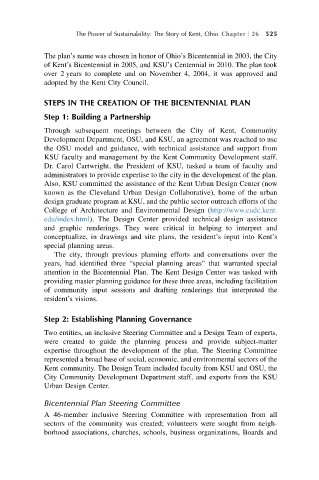Page 556 - Sustainable Cities and Communities Design Handbook
P. 556
The Power of Sustainability: The Story of Kent, Ohio Chapter j 26 525
The plan’s name was chosen in honor of Ohio’s Bicentennial in 2003, the City
of Kent’s Bicentennial in 2005, and KSU’s Centennial in 2010. The plan took
over 2 years to complete and on November 4, 2004, it was approved and
adopted by the Kent City Council.
STEPS IN THE CREATION OF THE BICENTENNIAL PLAN
Step 1: Building a Partnership
Through subsequent meetings between the City of Kent, Community
Development Department, OSU, and KSU, an agreement was reached to use
the OSU model and guidance, with technical assistance and support from
KSU faculty and management by the Kent Community Development staff.
Dr. Carol Cartwright, the President of KSU, tasked a team of faculty and
administrators to provide expertise to the city in the development of the plan.
Also, KSU committed the assistance of the Kent Urban Design Center (now
known as the Cleveland Urban Design Collaborative), home of the urban
design graduate program at KSU, and the public sector outreach efforts of the
College of Architecture and Environmental Design (http://www.cudc.kent.
edu/index.html). The Design Center provided technical design assistance
and graphic renderings. They were critical in helping to interpret and
conceptualize, in drawings and site plans, the resident’s input into Kent’s
special planning areas.
The city, through previous planning efforts and conversations over the
years, had identified three “special planning areas” that warranted special
attention in the Bicentennial Plan. The Kent Design Center was tasked with
providing master planning guidance for these three areas, including facilitation
of community input sessions and drafting renderings that interpreted the
resident’s visions.
Step 2: Establishing Planning Governance
Two entities, an inclusive Steering Committee and a Design Team of experts,
were created to guide the planning process and provide subject-matter
expertise throughout the development of the plan. The Steering Committee
represented a broad base of social, economic, and environmental sectors of the
Kent community. The Design Team included faculty from KSU and OSU, the
City Community Development Department staff, and experts from the KSU
Urban Design Center.
Bicentennial Plan Steering Committee
A 46-member inclusive Steering Committee with representation from all
sectors of the community was created; volunteers were sought from neigh-
borhood associations, churches, schools, business organizations, Boards and

